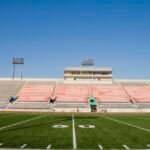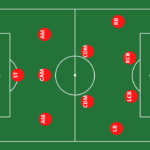7v7 Soccer Formations
- Last Updated -
What is the best 7v7 Soccer Formation?
Soccer is a game of strategy and skill, requiring players to work together to outmaneuver their opponents and score goals. The right formation can make all the difference in achieving victory, and the 7v7 format presents a unique set of challenges and opportunities.
With seven players on each side, finding the optimal balance between offense and defense is key. In this article, we will explore the most effective 7v7 soccer formations, their strengths and weaknesses, and tips for success.
The Classic 3-2-1 Formation
The 3-2-1 formation has gained popularity among teams seeking a more defensive style of play. It enables the team to maintain a solid backline of three defenders while still retaining control in midfield. The central defender is positioned higher than the fullbacks in this formation, highlighting their importance in stepping up to cover central areas in the absence of a dedicated central midfielder.
At times, the 3-2-1 formation can resemble the 2-1-2-1, with the main difference being the role of the central defender. In the 3-2-1, the central defender is typically a ball-playing center-half back, while in the 2-1-2-1, it’s usually a defensive midfielder.
The 3-2-1 formation has its advantages, such as providing strong defensive support and more midfield presence compared to the 3-1-2 formation. It also allows less skillful teams to overpower more fluid attacking formations.
However, the formation has its drawbacks, such as potential confusion for wide midfielders on when to move centrally or stay wide, and a lack of width if they remain too central. Additionally, the formation can upset team rhythm as the roles are less defined, and the central defender needs to step up into midfield when necessary.

2-1-2-1 Soccer Formation
The 2-1-2-1 formation is an innovative approach to the classic 2-3-1 formation, with a deeper central midfielder and higher wide players . This formation is very attack-oriented and supports a fast style of play, ensuring that the striker never becomes isolated. The shape of the formation is interesting and creative, making it difficult for opponents to know the best methods for counter-acting it.
However, there are a few drawbacks to the 2-1-2-1 formation. Attacking midfielders may be less inclined to help out in defense than if they were right/left midfielders in a 2-3-1 formation. If the defensive midfielder does not cover enough ground or gets caught too low, a massive gap can be created between the DM and AM’s. Additionally, a larger gap can be created between defenders and wide midfielders compared to the 2-3-1 formation.
Overall, with the right players and a central midfielder that can cover a lot of ground, the 2-1-2-1 formation could be the formation that catches any team by surprise . It also helps players clearly understand their role as either primarily an attacking player or a defensive player, which can help with the transition from the 5v5 game.

3-1-2 Formation
The 3-1-2 formation offers several advantages. With three strong defenders, the team can become indestructible in defense. The formation also helps forwards to learn how to work in a two-striker system and defend from the front. Additionally, it can be easier for strong, less skillful teams to overpower more skillful teams playing with more fluid attacking formations.
However, there are also some drawbacks to the 3-1-2 formation. The central midfielder is required to do a lot of running, and if they fail to do so, the opposing team may dominate the midfield. The formation can become overly defensive if the fullbacks don’t push up with the play, and it is not inherently rooted in a possession-based style of play. Nonetheless, these issues can be mitigated with fluidity in the fullbacks.
Overall, coaches and managers should consider the 3-1-2 formation for its defensive strength and tactical flexibility, particularly for younger players. While it has its drawbacks, it can be a valuable addition to any team’s formation repertoire.
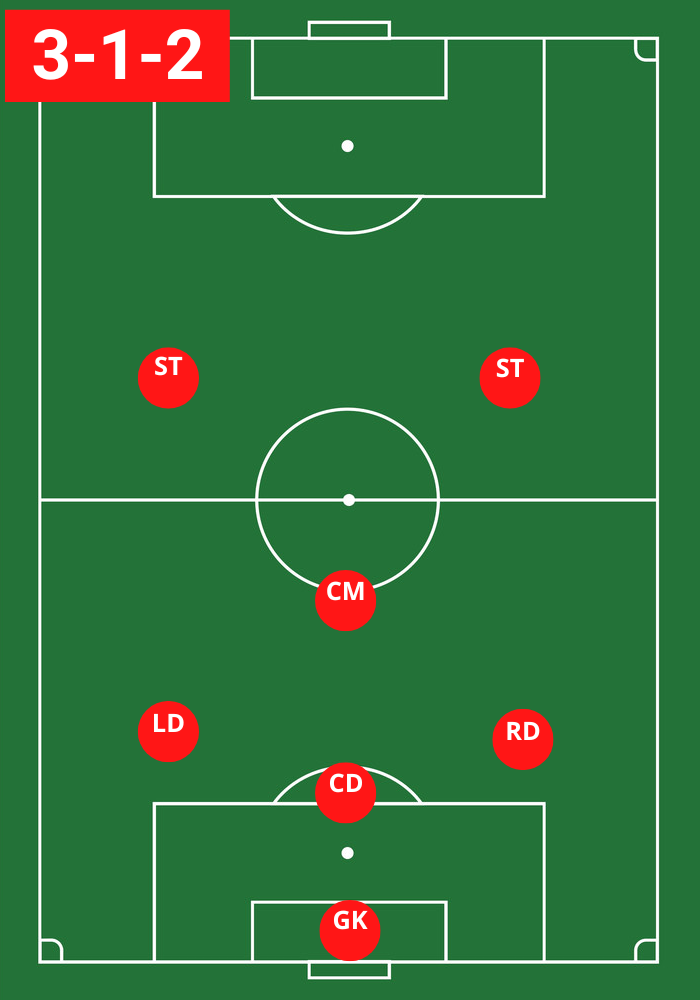
3-1-1-1 Formation
The 3-1-1-1 formation is considered one of the best formations to teach 7v7 players the tactics of the game. It’s an ideal formation to switch to when trying to protect a lead or hold on to a draw. The formation also offers greater midfield support for teams that prefer to play with a back three compared to the 3-1-2 formation.
The 3-1-1-1 formation is most effective when there are specific players who can fit into the defined roles or when the team has a shortage of wide midfielders. However, the formation is narrow, which makes keeping possession in central areas crucial. It can also be used to make the wing-backs the most important players in the game.
The 3-1-1-1 formation has its advantages, such as providing a strong defensive line with three defenders and offering midfield support without sacrificing the attacking threat of the second striker. It also allows less skillful teams to overpower more fluid attacking formations.
However, there are drawbacks to this formation. It can become very narrow, and the fullbacks must provide width at the right moments. Teams may struggle against opponents that overload in wide areas. The formation can become overly defensive if fullbacks don’t push up with the play. Additionally, it’s not rooted in a possession-based style of play.

2-3-1 Soccer Formation
The 2-3-1 formation is a classic 7v7 formation that provides excellent balance and is easy for young players to understand. The two defenders are supported by three hard-working midfielders, which offers ample support at the back without overloading defensive areas.
At the same time, the midfield can push forward, and the wide players provide width during attacks. The lone striker is usually backed up by a central midfielder who can play as either a 6 or 10, depending on the situation, combining the best of both roles. This formation is effective in scoring goals and defending against various formations.
To succeed in this formation, teams require hard-working midfielders who can contribute both in attack and defense, particularly a central midfielder. They also need wingers who can stay wide and make short sprints up and down the line, a centre forward who can hold the line alone, and defenders who do not create massive gaps between themselves.
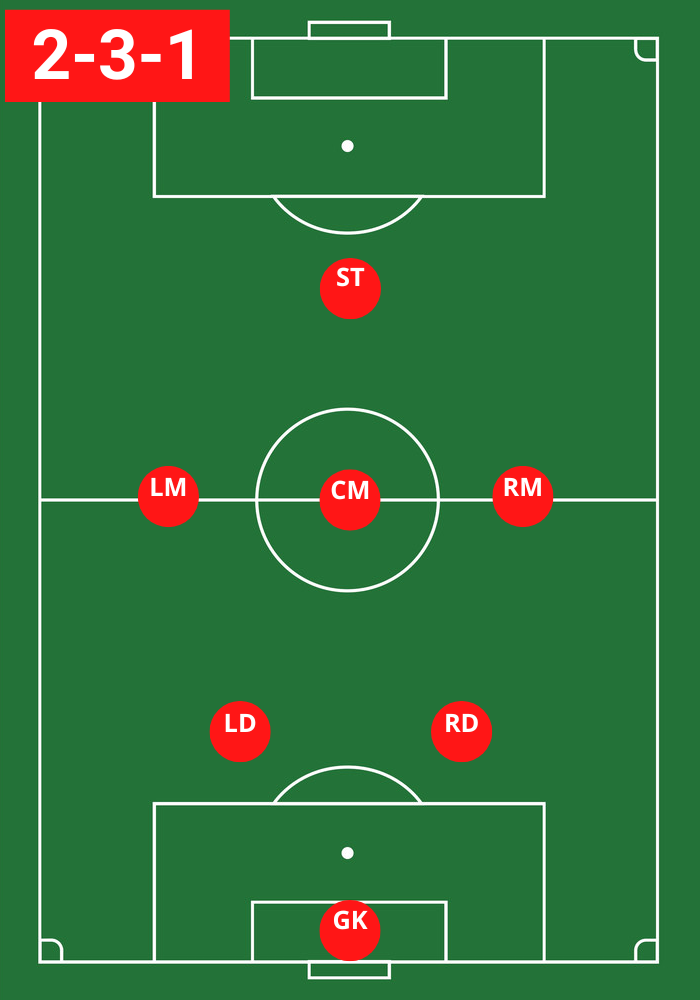
Tips for Success with 7v7 Soccer Formations
Regardless of which formation you choose, there are some key tips for success that can help your team dominate on the field. These include:
- Communication: Make sure your players are communicating effectively on the field, both in defense and attack.
- Movement: Encourage your players to move off the ball, creating space and opportunities for passes and shots.
- Flexibility: Be prepared to adjust your formation based on the strengths and weaknesses of your opponent and the game situation.
- Practice: Spend time on the training ground practicing different formations and scenarios, so your team is well-prepared for game day.
Q and A
Q: How do I choose the right formation for my team?
A: Consider the strengths and weaknesses of your players, the style of play you want to implement, and the opposing team’s formation and tactics. It’s also important to be flexible and willing to make adjustments during the game if needed.
Q: How can I encourage my team to move off the ball?
A: Incorporate drills in training that focus on movement off the ball, such as passing drills that require players to constantly change their position. Encourage players to look for space and make runs to create opportunities for themselves and their teammates.
Q: Is it better to focus on defense or offense in 7v7 soccer?
A: It’s important to find a balance between defense and offense in 7v7 soccer. While a strong defense can prevent goals, a strong offense is necessary to score goals and win games. Finding the right formation that fits your team’s strengths and weaknesses can help achieve this balance.
Conclusion:
Choosing the right 7v7 soccer formation is crucial for success on the field. Whether you opt for the classic 3-2-1, the 3-1-1-1, or the balanced 2-3-1, it’s important to consider the strengths and weaknesses of each formation and adapt to the game situation accordingly. Remember to focus on communication, movement, flexibility, and practice to give your team the best chance at winning.
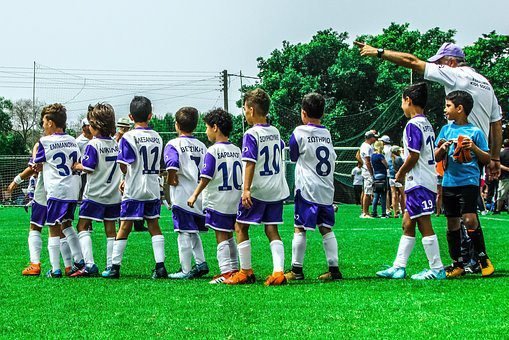
What is the hardest position in soccer to play?
What is The Hardest Position in Soccer Importance of understanding positions in...
Read MoreWhat is a Soccer Assist?
The Importance of Teamwork in Soccer The importance of teamwork in soccer...
Read MoreBest Goalkeeper Gloves 2024
What are the best goalkeeper gloves? When it comes to soccer equipment,...
Read MoreUnderstanding the 4-5-1 Soccer Formation
The Importance of Understanding the Formation Soccer is a tactical sport, and...
Read MoreWhat is the best soccer position to play?
What is the best soccer position? Soccer is a sport that requires...
Read MoreWhat is Soccer Relegation?
Introduction: Exploring the World of Soccer relegation Soccer is one of the...
Read MoreWhat is a cap in soccer?
If you're a soccer fan, you've probably heard the term "cap" being...
Read MoreSoccer vs Football Field – A Tale of Two Fields
Comparing the Corners: Soccer Field Vs Football Field Shapes Let's talk a...
Read MoreBest Indoor Soccer Shoes 2024
Indoor soccer has been gaining popularity over the years, with more and...
Read MoreHandball Rule In Soccer – Law #12
Soccer is one of the most popular sports globally, with millions of...
Read Moresoccer position numbers quick guide
Each player on the field has an important job as it relates...
Read MoreSoccer Substitution Rules: The Strategic Art of Changing the Game
Soccer, known as the beautiful game worldwide, has seen various changes to...
Read MoreDominate the Field With The 4-2-3-1 Soccer Formation
Soccer is a dynamic game that constantly evolves, and its tactics are...
Read MoreSoccer History USA: From Struggles to Successes
Soccer, also known as football, is the world's most popular sport, with...
Read More5-3-2 Soccer Formation: History and Tactics
Are you a soccer enthusiast looking to understand the tactical intricacies that...
Read MoreSoccer Overtime Rules: Everything You Need to Know
Introduction: Overtime Soccer Rules Everything You Need To Know Soccer is a...
Read MoreMastering Soccer Outside Back Position: Tips and Techniques
Soccer is a dynamic sport, and the outside back position is no...
Read MoreThe Mercy Rule In Soccer And The Roll It Plays
Picture this: a soccer match, with one team dominating the field and...
Read MoreSoccer Position Abbreviations – A Beginners Guide
Hey there! You've landed on "Decoding Soccer Positions: A Rookie's Handbook". This...
Read MoreBest Soccer Cleats for Flat Feet 2024
Unlock your soccer potential and tap into the game-changing secret: the ultimate...
Read MoreBest Youth Soccer Cleats for 2024 : Top 5 Pick
Welcome to our comprehensive guide on the best youth soccer cleats for...
Read MoreBox-to-Box Center Midfielder: The Engine of Modern Soccer Teams
Soccer is a game of skill, strategy, and teamwork. Every player has...
Read MoreBest Soccer Cleat Insoles 2024
What are the Best Insoles For Soccer Cleat? Are you a serious...
Read MoreBest Soccer Cleats for Turf 2024
What are the Best Soccer Cleats for Turf Fields? Look no further...
Read MoreSoccer’s Attacking Midfielder And The Crucial Role It Plays
The attacking midfielder position in soccer is a vital role that requires...
Read MoreBreaking Down the False 9 Soccer Position
The false 9 position is a term used in soccer to describe...
Read MoreThe Sweeper Soccer Position: A Versatile and Dynamic Role
The sweeper position was popularized in the 1960s and 70s by the...
Read MoreThe Role of a Center Defensive Midfielder
The Backbone of the Team: The Role of a Center Defensive Midfielder...
Read MoreSoccer Halftime: How Long Is It?
Halftime in FIFA and MLS matches is a fixed duration of 15...
Read MoreBest Grip Socks For Soccer 2025
In this post, we present the best grip socks for soccer, so...
Read MoreSoccer Corner Kick – Soccer Law #17
A corner kick is a type of free-kick that is awarded to...
Read MoreSoccer Yellow Card … What Does It Mean?
Yellow cards are used to maintain order and fairness on the soccer...
Read MoreUnderstanding the Six Soccer Defensive Positions
In this article, focused on six defensive positions: goalkeeper (GK), sweeper (SW),...
Read MoreThe Highest Scoring Games In Soccer History
Phew, after reading about the seven worst blowouts in soccer history, I...
Read MoreThe Power of a Goal in Soccer, How it Influences The Game
Football, commonly known as soccer, has established itself as a globally renowned...
Read More








